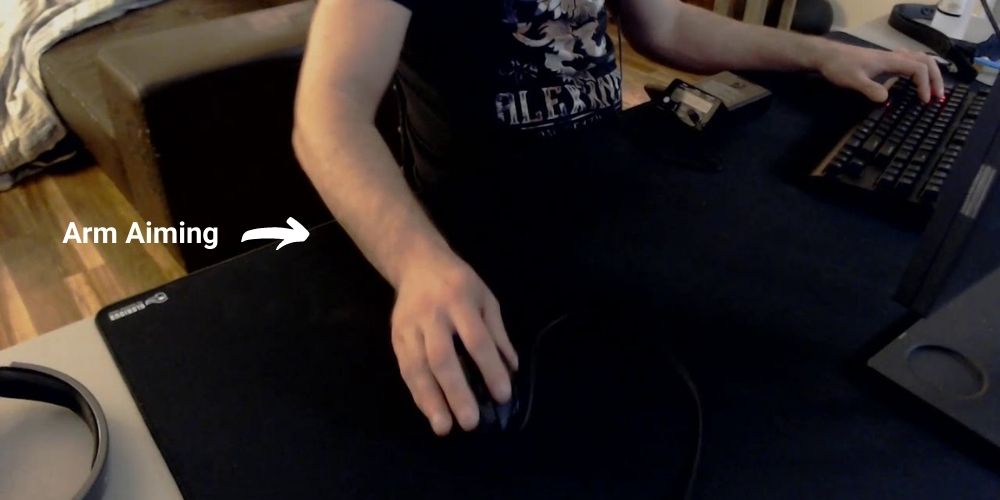Choosing between wrist aiming vs arm aiming doesn't have to be complicated.
There isn't one method of aiming that's better than the other. They both come with good, and bad.
I've been a competitive FPS gamer for many years, having tried both aim styles out.
Although arm aiming is more popular, wrist aiming has its pros too.
In this article, I will explain the differences between wrist aiming vs. arm aiming. And to prove once and for all, which "aim style" should you choose.
Let's dive in.
Wrist aiming is having your wrist on your table while your arm hangs off.
You perform your mouse movements with your wrist only.
This is what wrist aiming looks like.
If you have limited room to move around your mouse, you're a wrist aimer.
You will naturally increase your mouse sensitivity due to limited mouse spacing.
You'll have a similar posture to this:
Wrist aimers have a high sensitivity, an eDPI of >450.
A high eDPI is rare in the professional FPS gaming scene.
Wrist movements leave smaller room for error in your micro-movements.
Pros are laser-sharp aimers due to hours of aim practice daily.
They've trained their micro-movements to be accurate like Deadeye, from DC.
Although wrist aiming may seem "harder," if it comes naturally to you, then stick with it.
Aim training will make you a better aimer regardless of the aim type.
Pros:
Cons:
Wrist aiming places stress on your wrist, so you should stretch and warm up before gaming.
Reminder: Warm up and stretch before gaming to prevent long-term health issues.
Arm aiming has your wrist, forearm, and elbow on the table.
You perform your mouse movements with your entire arm, including your wrist.
This is what arm aiming looks like:
If you have ample desk space, you can choose between arm and wrist aiming.
But, if you have limited mouse space, you'll have to choose wrist aiming.
You have more control over your mouse movements because you have three points of contact:
You sit like this if you're arm aiming:

You can choose which part of your arm you will use to adjust to your aim.
When aiming, slight movements will use your wrist.
For more prominent flicks, you will use your forearm and shoulders.
You have more freedom of movement because you have more range of motion.
You can play at a lower sensitivity since you'll have more control over your flicks.
The typical eDPI for arm aiming gamers is <450 eDPI.
Arm aiming with an eDPI of <450 is common in the pro-FPS scene.
Pro players see the value of a large desk surface to move their mouse.
You'll have more freedom in your mouse movements with ample desk space.
Here are the pros and cons for arm aiming:
Pros:
Cons:
Pro-gamers use both arm aiming and wrist aiming.
Arm aiming is more common. It's easier to use and better for large desk spaces.
Pro-VALORANT gamers such as brax and TenZ use arm aiming, with an eDPI of <450.
Other pro-players like Hiko use wrist aiming, with an eDPI of >450.
If you're a beginner starting, arm aim.
Arm aiming is easier to pick up since you're using three points of contact.
If you have limited mouse space, wrist aim.
Wrist aiming is better if you prefer smaller movements, or have a small surface area to play with.
It's harder to control compared to arm aiming because of your naturally high sensitivity.
But with some aim training, you'll get used to it.
If you prefer a game-specific approach, use this instead:
According to Voltaic (a famous FPS aim coach), he states:
Aim to use a sensitivity between 20cm/360° to 50cm/360°. You should use a low sensitivity for slow, "click-timing" reliant games such as CS:GO and VALORANT. You should use a high sensitivity for "tracking" reliant games such as Apex Legends and Overwatch.
A high-quality gaming desk will complement helps by providing adequate room to move your mouse around.
More mouse space means more room for micro-corrections, and limits errors caused by your spacing.
The Eureka Z1-S is the desk I would recommend buying.
The desk comes with all the desk space you'll ever need.
If you flick and aim hard, the table won't budge at all.
And it won't break the bank. More money, less problems.
Once you're settled, do some aim training to drill in your muscle memory.
Through muscle memory, you'll become a human aimbot.
And don't forget to warm up before gaming. For your long-term health.
If you're interested in becoming a human aimbot, check out our aim training guides below.
Happy gaming!